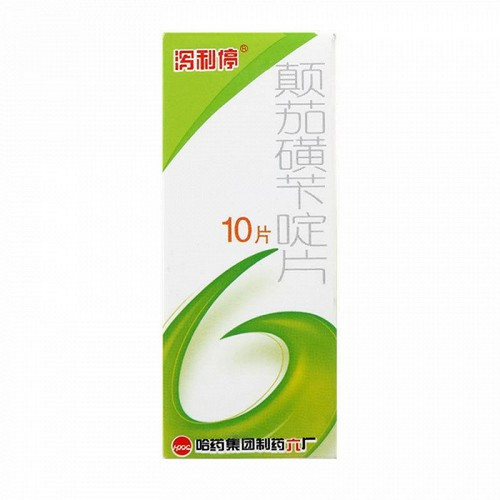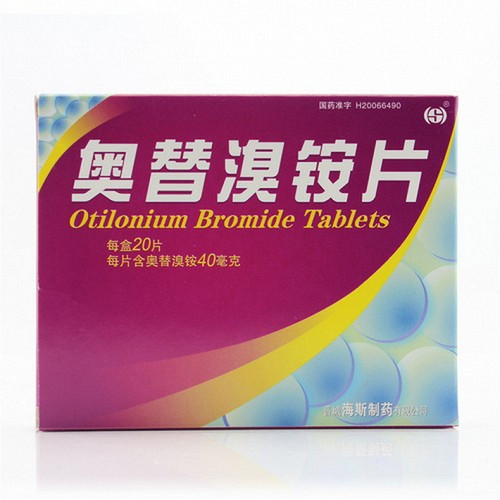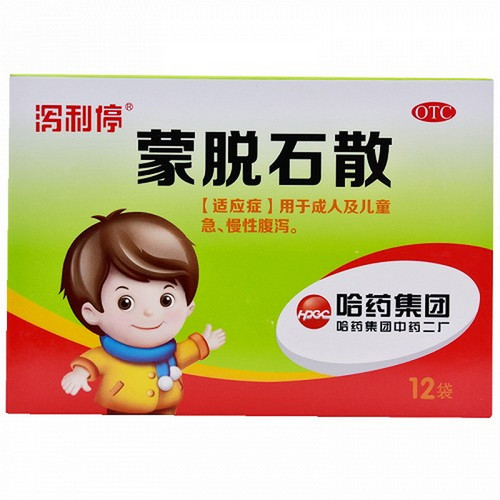Product Overview
[Drug Name]
Generic Name: Belladonna Sulfonyl Benzoate Tablets
Trade Name: Xieliting Belladonna Sulfonyl Benzoate Tablets 0.122g*20 Tablets
Pinyin Code: XieLiTing DianQieHuangZuoZuoPian 0.122g*20 Tablets
[Main Ingredients]
Sulfamethoxazole 1g, Trimethoprim 2mg, Belladonna Fluid Extract 2mg
[Properties]
Off-white tablets.
[Indications/Main Functions]
Indicated for chronic bacillary dysentery caused by Shigella dysenteriae and enteritis caused by other susceptible pathogens.
[Specifications]
0.122g*20 tablets
[Dosage and Administration]
Oral. Double the initial dose: 1-2 tablets once for children 2-5 years old; 2-4 tablets for children 5-12 years old, twice daily. A course of treatment is 1-5 days. Continued use requires medical advice.
Adverse Reactions:
1. Allergic reactions are common and may manifest as drug rashes. Severe cases may include exudative erythema multiforme, exfoliative dermatitis, and epidermolysis bullosa atrophic dermatitis. Serum sickness-like reactions such as photosensitivity, drug fever, joint and muscle pain, and fever may also occur. Anaphylactic shock may occur occasionally.
2. Neutropenia or neutropenia, thrombocytopenia, and aplastic anemia. Patients may experience sore throat, fever, pallor, and a bleeding tendency.
3. Hemolytic anemia and hemoglobinuria. This is more common in patients with glucose-6-phosphate dehydrogenase deficiency after taking sulfonamides and is more common in neonates and children than in adults.
4. Hyperbilirubinemia and neonatal kernicterus. Because this drug competes with bilirubin for protein binding sites, it can increase free bilirubin. Neonates have imperfect liver function and poor bilirubin processing, making hyperbilirubinemia and neonatal jaundice more likely to occur, and kernicterus may occasionally occur.
5. Liver damage. Jaundice and decreased liver function may occur, and in severe cases, acute hepatic necrosis may occur.
6. Kidney damage. Crystalluria, hematuria, and casts may occur; occasionally, patients may experience serious adverse reactions such as interstitial nephritis or renal tubular necrosis.
7. Nausea, vomiting, decreased appetite, diarrhea, headache, and fatigue, generally mild. Occasionally, patients may develop Clostridium difficile enteritis, in which case the drug should be discontinued.
8. Thyroid enlargement and hypofunction may occur occasionally.
9. Central nervous system toxicity may occur occasionally, manifesting as confusion, disorientation, hallucinations, euphoria, or depression.
10. Dry mouth, blurred vision, increased heart rate, flushing, and dizziness. Severe cases may cause mydriasis, excitement, and irritability.
[Contraindications]
1. Contraindicated in patients with allergies to SMZ and TMP.
2. Contraindicated in patients with megaloblastic anemia.
3. Contraindicated in pregnant and lactating women.
4. Contraindicated in neonates and infants under 2 months of age.
5. Contraindicated in patients with severe hepatic or renal impairment.
6. Contraindicated in patients with glaucoma or elevated intraocular pressure.
7. Contraindicated in patients with tachycardia.
8. Contraindicated in patients with benign prostatic hyperplasia.
9. Contraindicated in patients with pyloric obstruction.
[Drug Interactions]
1. Concomitant use of urinary alkalinizing agents may increase the solubility of this drug in alkaline urine, leading to increased excretion.
2. Do not use with para-aminobenzoic acid, as para-aminobenzoic acid may displace this drug from bacterial uptake, resulting in antagonistic interactions.
3. When used concomitantly with the following drugs, this drug may displace their protein binding sites or inhibit their metabolism, resulting in prolonged drug action or toxic reactions. Therefore, the dosage of these drugs should be adjusted when used concurrently with or after this drug. These drugs include oral anticoagulants, oral hypoglycemic agents, methotrexate, phenytoin sodium, and thiopental sodium.
4. Concomitant use with myelosuppressive drugs may enhance the adverse effects of these drugs on the hematopoietic system. For example, if there is a clear indication for co-administration of the two drugs, such as leukopenia or thrombocytopenia, close observation for possible toxic reactions should be conducted.
5. Long-term co-administration with contraceptives (estrogens) may reduce contraceptive reliability and increase the chance of extramenstrual bleeding.
6. Co-administration with thrombolytic drugs may amplify their potential toxic effects.
7. Co-administration with hepatotoxic drugs may increase the incidence of hepatotoxicity. Liver function should be monitored in such patients, especially those taking the drug for a long time and those with a history of liver disease. 8. Additive photosensitivity may occur when co-administered with photosensitizing drugs.
9. Patients receiving this drug have an increased requirement for vitamin K.
10. Co-administration with methenamine is not recommended, as methenamine decomposes in acidic urine to produce formaldehyde, which can form an insoluble precipitate with this drug, increasing the risk of crystalluria.
11. This drug can replace the plasma protein binding site of phenylbutazone, and co-administration may enhance the effects of phenylbutazone.
12. When sulfinpyrazone is used in combination with this product, it can reduce the latter's secretion from the renal tubules. Prolonged elevations in blood concentrations can easily lead to toxic reactions. Therefore, the dose of this product may need to be adjusted during or after sulfinpyrazone treatment. When sulfinpyrazone treatment is prolonged, blood concentrations of this product should be monitored to facilitate dosage adjustments and ensure safe use.
13. The trimethylolpropane (TMP) in this product can inhibit the metabolism of warfarin and enhance its anticoagulant effect.
14. The TMP in this product can increase nephrotoxicity when used in combination with cyclosporine.
15. When rifampicin is used in combination with this product, the clearance of TMP in this product can be significantly increased and its serum half-life shortened.
16. This product should not be used in combination with antineoplastic drugs or 2,4-diaminopyrimidines, nor between courses of treatment with other folic acid antagonists, as it may cause bone marrow aplasia or megaloblastic anemia. 17. Do not use this product with dapsone, as the combined use of dapsone and the trimethoprim-sulfamethoxazole (TMP) in this product can increase the blood concentrations of both drugs. This increased dapsone concentration can increase and exacerbate adverse reactions, especially methemoglobinemia.
18. Avoid co-administration with penicillins, as this product may interfere with the bactericidal effects of these drugs.
[Precautions]
Use with caution in patients with hepatic or renal impairment, hypertension, diabetes, gastric or duodenal ulcers, and heart failure. Avoid taking this product after meals if experiencing upper abdominal distension, nausea, or vomiting. Drink plenty of fluids when taking this product. Use in pregnant and lactating women: Sulfonamides can cross the placenta and are secreted in small amounts in breast milk. Animal studies have shown teratogenic effects and the potential for causing kernicterus in newborns. Therefore, this product should not be used by pregnant and lactating women.








